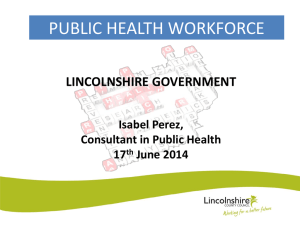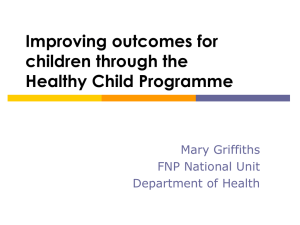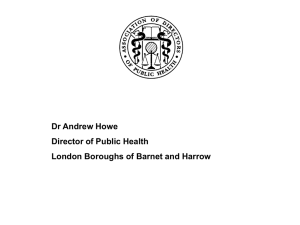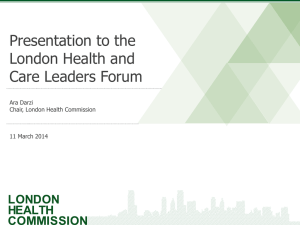Health & wellbeing assessment The HWA process
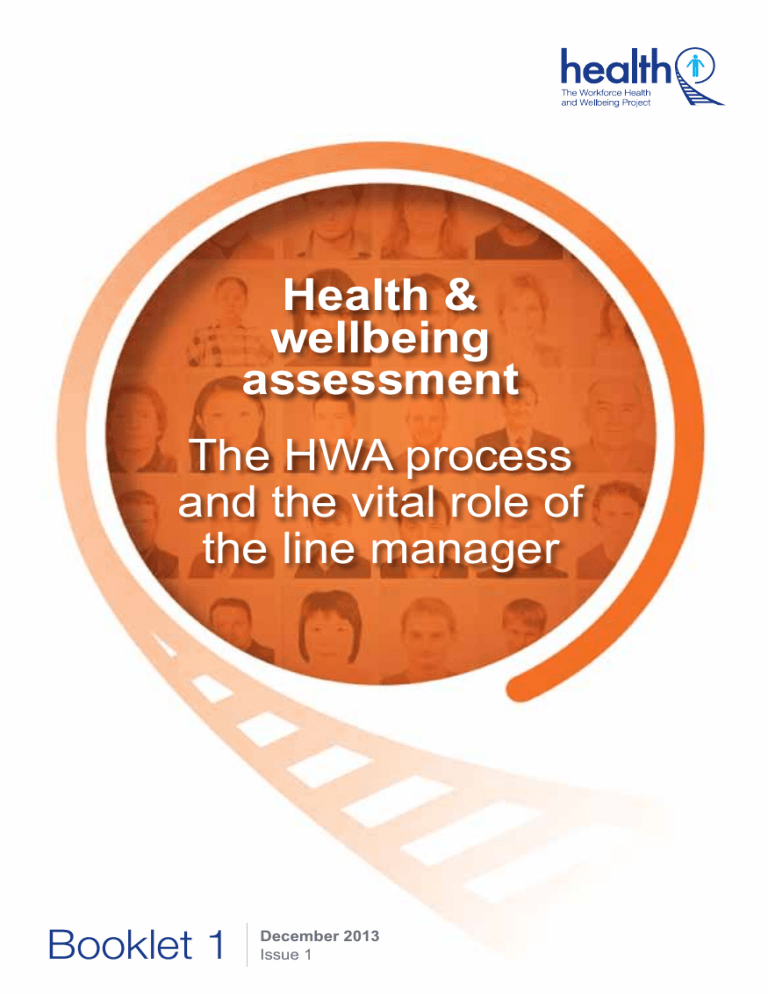
Health & wellbeing assessment
The HWA process and the vital role of the line manager
Booklet 1
December 2013
Issue 1
1
Introduction and background
It is easy to understand that the health and wellbeing of a person can have an impact on their work. It is just as important to be aware that their work can have an impact on their health and wellbeing.
Work can affect your health
Health can affect your work
Carrying out a health and wellbeing assessment helps people understand their workplace and the people within it in order to make it a better place to work.
As line managers, it is part of our role to look out for the health and wellbeing of the people we work with. In doing this, we can make our workplaces more pleasant and trusting environments, as well as more productive places of work.
Just standing back and taking a fresh look at things can often mean we can find quicker, smarter and healthier ways of working that cost nothing other than thought and a willingness to help.
We do not need to be experts to carry out health and wellbeing assessment effectively. We are all capable of checking, looking around us and putting ourselves in the shoes of others we work with. We are so often in the best position to notice what is going on locally and to respond to any issues in the most appropriate and timely manner.
Purpose of the health and wellbeing information suite
This particular document focuses on helping supervisors and line managers to incorporate health and wellbeing assessments into their daily activities.
This booklet forms part of a suite of information aimed at increasing awareness of the need for all those involved with supervision and management to consider and improve health and wellbeing in the workplace.
Other elements of the Health and Wellbeing suite include:
• A DVD containing an introductory video, plus case studies and all of the resources set out below
• Checklists and additional reference material in Booklet 2, as well as the
3 areas of health & wellbeing and how to approach them
• Posters of each various aspect of HWA
• Briefing and workshop session plans
& guidance (Booklet 3) and associated presentation materials
Purpose of this document
This document aims to help you:
• Recognise the practical things that you can do and consider that can protect and improve the health and wellbeing of yourself and others
• Understand and apply a step by step process for assessing health and wellbeing
2
3
Health and wellbeing assessment
the 5-step HWa process
Identifying the need
ProactIve management of health risks reactIve management of health risks assessing the risk
Monitoring
& reviewing
1
What are the Health issues?
2
Who does this apply to?
3
How serious is it?
4
What needs to be done?
5 are the controls working?
The diagram opposite sets out a simple five-step set of questions for us to answer. Following this process a step at a time can help us clarify an issue as well as identifying how it can be solved.
Identifying the need
P r
The starting point for following the process may be proactive in that is either a new activity or a planned review. It may also be reactive in that an individual has reported an issue or it may be due to a report of ill health or absence.
assessing the risk
1
What are the health issues?
Understand what people do and what they are exposed to that may affect their health and wellbeing
2
Who does this apply to?
Clarify who might be affected by the health issues and the effect it may have
3
How serious is it?
Evaluate the risks. Consider both consequence (how bad) and frequency
(how often) and decide whether there is there a need for additional action
4
What need to be done?
Decide what needs to be done about the issue. Think about what controls you have in place and how the work is organised. Compare this with good practice and see if there’s more that can be done. Make sure you record your assessment
Monitoring and review
5
are the controls working
Regularly review the assessment and controls - and update if necessary.
This may be due to a planned change, review timescales or something else that has altered
4
5
1
What are the Health issues?
2
Who does this apply to?
3
How serious is it?
4
What needs to be done?
5 are the controls working?
aim to consciously look around and identify issues that may adversely affect the health and wellbeing of people around the workplace clarity of purpose
It is important that we are able to stand back from time to time and view things that are going on from a wider perspective, whilst holding the aim of improving the health and wellbeing of our people firmly in mind
Practical things you can do:
• Set time aside to look at what health issues may be affecting your workplace.
• Look at things you are used to seeing through fresh eyes – put yourself in someone else’s shoes. This technique can help us see things that have become unconscious (or invisible) because we are so used to them.
• Consciously look out for early signs of ill health caused by work. Bear in mind that some health conditions take a long time to show
• Listen to what the people around you say – sometimes it is worth picking up on somebody’s ‘throw-away line’ to see if there is more to something than initially meets the eye
• Appreciate that some issues may have been around for a long time and seem difficult to solve - but they are present and need to be recognised other thoughts and considerations
• Walk around the workplace and talk to the people that work there. Discussion and insight from trusted, experienced employees can often be quite revealing
• Have a look back at your accident and ill-health records – these often help to identify the less obvious hazards
• Liaise with your specialist health and safety managers for advice and to look at any generic risk assessments carried out for the activities concerned
• Remember to consider any longer-term exposure to minor hazards to health can be far more serious compared to occasional exposure (for example high levels of noise or exposure to harmful substances)
6
7
1
What are the Health issues?
2
Who does this apply to?
3
How serious is it?
4
What needs to be done?
5 are the controls working?
aim to identify the scale of a health and wellbeing issue - and consider who might be affected over a period of time clarity of purpose
However we have learned about a health and wellbeing issue, it is important that we consider whether it is an isolated case or if it is likely to apply to others
Practical things you can do
• If an issue has been identified through an individual matter, consider whether it may also apply to others carrying out similar work
• If you share your workplace, think about how your work affects others, as well as how their work affects your people – talk to them and ask your people if they can think of anyone you may have missed
• Keep talking to people. It is better to talk through issues and make a few mistakes than ignore problems
• Listen to issues raised and understand the problem before worrying about how to resolve it other thoughts and considerations
• If looking at a group issue, are certain individuals more vulnerable?
• Remember that the most vulnerable people (those with existing health conditions, or expectant mothers for example) are more likely to suffer harm and will therefore need greater protection from it
Does this one represent many others?
Does one need particular attention?
8
9
1
What are the Health issues?
2
Who does this apply to?
3
How serious is it?
4
What needs to be done?
5 are the controls working?
aim to recognise and evaluate the implications of what is happening so we can respond in an appropriate and timely manner clarity of purpose
It is important to make sure we look into the issue in enough depth so we can make good decisions and move forward in a manner that is reasonable rather than doing too much or not enough
Practical things you can do
If you are not sure how serious something is, options you have include:
• Seeking the help of specialists through the relevant department of your organisation such as your occupational health hygenists, health and safety representatives, etc
• Search the internet or review documents that are available to you within your organisation
• Talking to others - Are there any examples of good or useful practice?
other things you can do:
• Speak about the issue to the people doing the work to understand what is going on
• Keep gathering information until it becomes clear how you should act
• Make decisions based upon the information you have in front of you, rather than stopping because it seems too difficult. Seek to change the way things are done, asking people to change, etc.
• Consider whether you need to action some ‘quick fixes’ to protect people now whilst longer-term solutions are considered
• Consider whether an average environment can be improved so that it becomes a more enjoyable place of work other thoughts and considerations
• Recognise that more serious issues need a quicker response
• Remember to think about both the short and longer-term effects
• Look into the patterns of issues and incidents and consider their root causes
10
11
1
What are the Health issues?
2
Who does this apply to?
3
How serious is it?
4
What needs to be done?
5 are the controls working?
aim to take action that is realistic, achievable and effective in to improving the health and wellbeing of our people clarity of purpose
It is useful to look at what is already happening; think about the things that are in place and how the work is organised. We can then compare this with common sense and any known good practice. This will enable us to see if there’s more that can be done
Practical things you can do
• Share what you have found with those that need to know (employees, safety reps)
• Get others involved with deciding the best way forward - create an informal team with mixed experience and perspectives to help talk through practical ideas and options
• Prioritise what needs to be done - taking account of practicalities and legal obligations
• Imagine what it will look like if the changes are working well - mentally rehearse ideas for solutions along with their longer-term implications through discussion with others concerned
• Manage expectations of those involved or concerned - it is more likely to be evolution rather than revolution
• Write down an outline plan using each of the five steps as headings other thoughts and considerations
• Consider: Can we get rid of the issue altogether? If not, how can we control the issue so that any potential harm is minimised?
• In the case of issues that are undermining wellbeing, such as untenable psychological pressures, it is often most useful for those experiencing the issue to suggest ways the pressure can be reduced to a sustainable level
• Within any plan, you may find you need to have temporary ‘first aid’ fixes as well as solutions that may take longer to put in place
12
13
1
What are the Health issues?
2
Who does this apply to?
3
How serious is it?
4
What needs to be done?
5
are the controls working?
aim to review what we have done to understand what has worked well, what can be improved and what may need changing clarity of purpose
After taking action to implement changes to address a health and wellbeing issue, it is important to take a little time to look back at whether our plan worked in practice
Practical things you can do
• Check progress against your plan
• Keep an eye on the effect of any changes made. It can be useful to set yourself a reminder on your calendar or phone other thoughts and considerations
• Add in HWA checks that can be carried out at the same time as other company procedures (eg. planned inspections, etc.)
• Accept that any plan is a best guess and be prepared to adapt it to improve what is actually happening as you monitor over a period of time
• Reviewing the HWA annually will make sure we are still improving - or at least not sliding back
14
15
the 5 steps and the line managers vital role
When it comes to using the 5 steps within the organisation how much effort each step will take depends upon the difficulty of managing the issue identified. It may be that for simple issues the 5 steps can be carried out by a few people without much effort. For more complex issues it may be that it will take a number of roles to work hard to resolve the issue. Either way the line manager’s role is vital to start the process off.
For an organisation to manage a health and wellbeing issue it is just a matter of applying the proportionate amount of resource (employee effort and cost) to come up with adequate solutions. However, if the organisation does not become aware of the issue then it cannot resolve it and the risk remains as a weakness within the organisation. The line manager and their employees have the most experience of the everyday tasks of the organisation. If they do not raise health issues then there is a good chance that they may be missed altogether.
Within the 5 step process it is really the first two steps where line managers make all the difference. The other steps may or may not need other people but if the line manager does not initiate the process the organisation will struggle to pick up its weaknesses.
If you do nothing else be aware of your vital role in steps 1 and 2 of the
HWa process and be prepared to start them off.
1
What are the Health issues?
2
Who does this apply to?
3
How serious is it?
4
What needs to be done?
5 are the controls working?
16
HWa tools and resources
Here is an overview of the tools and resources that are available for you and your organisation to make use of - or to amend to suit your needs
DVD and resource files
Guidance booklets for managers health & wellbeing introduction health & wellbeing case studies health & wellbeing guidance health & wellbeing resources which area would you like
to explore?
Display posters health & wellbeing introduction health & wellbeing case studies health & wellbeing introduction health & wellbeing case studies health & wellbeing health & wellbeing
introduction
guidance health & wellbeing health & wellbeing health & wellbeing resources health & wellbeing guidance health & wellbeing resources health & wellbeing health & wellbeing case study videos health & wellbeing health & wellbeing
17
which area which area
which area
would you like
to explore?
Training and briefing plan (with guidance) and PowerPoint slides
18
The HWA process and the vital role of the line manager
Booklet 1
December 2013
Issue 1
The Workforce Health and Wellbeing
Project is facilitated by RSSB.
If you have any questions about this resource, please contact whwp@rssb.co.uk
